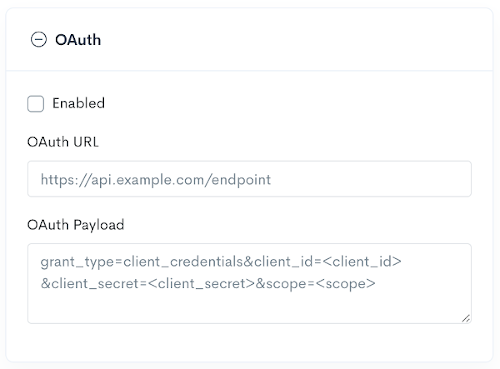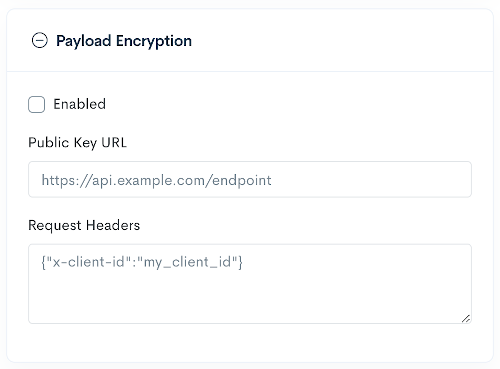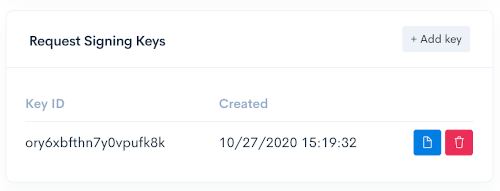Appearance
Webhook Security
The Cardswap system can also apply additional security measures to webhook events sent to partners. These measures include oauth authentication, payload encryption and request signing.
OAuth Authentication
The webhook can be set up to retrieve a client credentials token from an OAuth endpoint provided by the partner. The OAuth response must follow the standard client credentials format. This token will be cached in Cardswap until its expiration nears and at that point another token will be requested from the endpoint. The resulting token will be passed as a Bearer token in the Authorization header along with the event payload.
Setup in Nexus
- In the Nexus portal
Settingsview, click theEditbutton on the desired webhook. - Expand the
OAuthsection of the webhook properties. - Enable OAuth support by toggling the checkbox.
- Add in the
OAuth URLprovided by the partner. - Add in any
OAuth Payloadthat should be included in the OAuth request in URL format.

Example Encrypted Request
HTTP/1.1 200 OK
Content-Type: application/jose+json
eyJhbGciOiJSU0ExXzUiLCJlbmMiOiJBMTI4Q0JDLUhTMjU2In0.
UGhIOguC7IuEvf_NPVaXsGMoLOmwvc1GyqlIKOK1nN94nHPoltGRhWhw7Zx0-kFm
1NJn8LE9XShH59_i8J0PH5ZZyNfGy2xGdULU7sHNF6Gp2vPLgNZ__deLKxGHZ7Pc
HALUzoOegEI-8E66jX2E4zyJKx-YxzZIItRzC5hlRirb6Y5Cl_p-ko3YvkkysZIF
NPccxRU7qve1WYPxqbb2Yw8kZqa2rMWI5ng8OtvzlV7elprCbuPhcCdZ6XDP0_F8
rkXds2vE4X-ncOIM8hAYHHi29NX0mcKiRaD0-D-ljQTP-cFPgwCp6X-nZZd9OHBv
-B3oWh2TbqmScqXMR4gp_A.
AxY8DCtDaGlsbGljb3RoZQ.
KDlTtXchhZTGufMYmOYGS4HffxPSUrfmqCHXaI9wOGY.
9hH0vgRfYgPnAHOd8stkvwPayload Encryption
Event messages to webhook endpoints may be encrypted using standards-based JWE (JSON Web Encryption) compact formatting. In the case of JWE formatting the key ID (kid) is stored in the JWE header included in the encoded payload.
JWE Settings
- Format -
compact- The format of the JWE itself. Compact is an efficient encoded string. - Content Algorithm (enc) -
A256GCM- The symmetric algorithm used to encrypt the actual content. - Key Wrapping Algorithm (alg) -
RSA-OAEP- The asymmetric algorithm used to encrypt the symmetric key.
Setup in Nexus
- In the Nexus portal
Settingsview, click theEditbutton on the desired webhook. - Expand the
Payload Encryptionsection of the webhook properties. - Enable encryption support by toggling the checkbox.
- Add in the
Public Key URLprovided by the partner. - Add in any
Request Headersthat should be included with the request in JSON format.

Example
SignatureJWT Headers
json
{
"typ": "JWT",
"alg": "RS256",
"kid": "key_id_3",
"x5t": "Mx3Fyhwerew23wfs"
}Example
SignatureJWT Claims
json
{
"aud": "audience.example.com",
"iss": "example issuer",
"exp": 1579754951
}RSA Request Signing
Webhook requests may include a request signature for verification. In the case of webhooks, a signed JWT (JSON Web Token) will be created and sent in a header of the webhook event request. The header defaults to signature but this can be customized to whichever header the partner would like.
RSA Signing Keys
RSA request signing key-pairs can be created in the Nexus portal Settings view, and the public key can be copied.
- A maximum of 2 keys can be created for key rotation purposes.
- Public keys are copied in PCKS #8 format.
- Public keys can also be retrieved from the partner public key API.
- The oldest key of the two will be used to create the request signature

Request Signature Setup
- In the Nexus portal
Settingsview, click theEditbutton on the desired webhook. - Expand the
Request Signaturesection of the webhook properties. - Enable signature support by toggling the checkbox.
- All parameters for the request signature are optional.
Token Issuer- Specifies theissvalue to be included with the JWTToken Audience- Specifies theaudvalue to be included with the JWTSignature Header- Specifies a request header other thansignatureto use for the signature JWT
